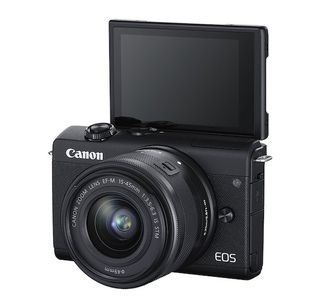Canon brings its affordable EOS M200 mirrorless camera to Australia
An entry-level snapper with 4K video and eye detect AF

After a gap of two years, Canon gave its entry-level EOS M100 APS-C mirrorless camera a refresh in the form of the EOS M200. The new snapper was launched in most markets in September 2019 but, at the time, Canon Australia said there were no plans to bring the EOS M200 Down Under.
Things have changed in the last five months, as Canon has decided to release the M200 in Australia as well, and it brings with it some much-needed improvements over its predecessor.
Also aimed at beginners, or those looking to step up from smartphone photography, the M200 is almost physically identical to the older model but there are some major differences under the hood.
While the resolution stays the same, there's a very slight change in effective pixel count, with the M200 coming in at 24.1MP (while the M100 has a 24.2MP sensor), indicating there's a brand new sensor under the hood.
- Best cheap cameras in 2020: 10 budget DSLRs, compacts and mirrorless snappers
- Best entry-level mirrorless cameras available in 2020
Alongside the new sensor sits Canon's latest Digic 8 image processor, taking over the Digic 7 in the M100. It's the same engine that has been used in the EOS 90D and EOS M6 Mark II, adding a definite performance boost to both the APS-C cameras that were released in August last year. This latest engine adds 4K video recording capabilities to the M200 with a maximum frame rate of 30fps. However, recording at 4K comes with a 1.6x crop factor. HD videos can be shot at up to 120fps for a 4x slow-motion effect. There's also support for vertical video capture.
The new imaging engine and sensor pairing is also what allows the M200 to boast a better autofocus system than its predecessor. Where the M100 had a 49-point phase -detect AF system, the new snapper arrives with a generous 143 points, with eye detection AF also on offer. The AF system is also capable of handling low light, with the camera able to focus down to -4EV (exposure value).
There's an update to the white balance system as well, with the addition of ambient-priority and white-priority to the auto white balance mode, which is not available on the M100.
Get daily insight, inspiration and deals in your inbox
Get the hottest deals available in your inbox plus news, reviews, opinion, analysis and more from the TechRadar team.

Spot the difference
In terms of design, the M200 looks very much like it predecessor. There's still no viewfinder – instead you'll be using a flip-up touchscreen display that's perfect for selfies. There's no mode dial on the shoulder, so most settings will need to be changed via the touchscreen.
That said, the Wi-Fi button from the rear of the M100 has disappeared from the M200, with the movie record button (which was on the top of the M100) taking its place instead.
Besides that, both Wi-Fi and Bluetooth are available on board for easy sharing of images, as are Canon's Creative Assist modes for learning new skills. There's also the Self Portrait mode, important for a camera aimed at taking selfies.
Although the changes to the M100 seem like an incremental update, the M200 is aimed at entry-level users and could shape up to be one of the best APS-C mirrorless cameras for beginners, especially if it also carries the very friendly price tag it does overseas. If we extrapolate from the US$549 price tag, which includes the 15-45mm kit lens, we're expecting the camera to cost Aussies around AU$800, with the lens.
To make the camera more appealing to younger generations, Canon is also releasing face jackets of different colours that can be purchased separately to dress it up, so to speak, to match users' individual styles.
The Canon EOS M200 will be available at major Australian retailers starting February 2020 and we'll update this story with the exact pricing when we find out more.

Sharmishta is TechRadar's APAC Managing Editor and loves all things photography, something she discovered while chasing monkeys in the wilds of India (she studied to be a primatologist but has since left monkey business behind). While she's happiest with a camera in her hand, she's also an avid reader and has become a passionate proponent of ereaders, having appeared on Singaporean radio to talk about the convenience of these underrated devices. When she's not testing camera kits or the latest in e-paper tablets, she's discovering the joys and foibles of smart home gizmos. She's also the Australian Managing Editor of Digital Camera World and, if that wasn't enough, she contributes to T3 and Tom's Guide, while also working on two of Future's photography print magazines Down Under.
Most Popular


